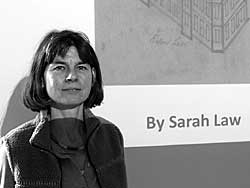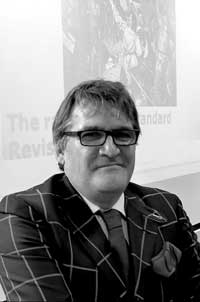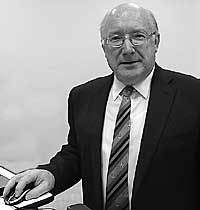Events and excursions, Winter 2012/13
SATURDAY 10 NOVEMBER 2012. THE NOTTINGHAMSHIRE HISTORY LECTURE. THE DESIGNED LANDSCAPE OF RUFFORD ABBEY, 1700-1750, BY SARAH LAW.

This years Nottingham History Lecture was given by Sarah Law of the School of Geography at the University of Nottingham. Her lecture 'The Designed Landscape of Rufford Abbey, 1700-1750' gave her audience a brief introduction to her on-going researches into the gardens and estate of one of Nottinghamshire's most important country houses. Rufford was the third largest house in the county according to the Hearth Tax Returns of 1674. Though very little of this once important garden survives today, the wealth of visual material available from the Savile Papers deposited in the Nottinghamshire Archives allowed Dr Law to illustrate her lecture profusely. The surviving documents tell a complex story of the development of these gardens and Dr Law steered a clear and intelligent path through this detailed archival material. She introduced her audience to some of the extremely complex and unusual garden features which were designed for Rufford — such as the '1735' design for the water gardens — and she was able to put these features into their wider economic, aesthetic and social context of early-18th century Nottinghamshire.
Pete Smith
SATURDAY, 8 DECEMBER 2012. THE NEVILLE HOSKINS LECTURE: THE RAISING OF THE STANDARD REVISITED: TWENTY YEARS ON BY PROFESSOR MARTYN BENNETT

Professor Martyn Bennett is professor of early modern history and Head of the Graduate School at Nottingham Trent University.
Professor Bennett began by reviewing his lecture to the Society given in 1992 and subsequently published in the Transactions : ‘the King’s Gambit: Charles l and Nottingham in the summer of 1642’. (TTS 96 1992, 135-45). He explained in the twenty years since then a great deal of re-thinking and new research – social, economic, political, cultural and religious – had been undertaken concerning the complexities of the events of the reign of Charles l, not only by himself but also others, the outcome of which had resulted in a substantial re-appraisal if not an academic shift. This was not to admit failure or getting things wrong but rather a re-focusing of attention on the period by a new generation of scholars such as Professor Bennett, in contrast to an older generation of scholars who had interpreted the same events and evidence in a distinctly different manner.
In his re-consideration of the raising of the standard Professor Bennett now regarded it not as an opening move in the civil war but more of a symbolic act, an attempt to raise an army in England and Wales to oppose Parliament, with many of his supporters not in attendance as they were engaged on his behalf elsewhere, and thus a new phase of existing wars and rebellions. The antecedents of the wars in the three kingdoms had their origins in the 1630s. The Scots had been provoked by Charles’ religious policies (1637) and Ireland rebelled when Catholics were denied the same reforms effected in Scotland, England and Wales (1641), and because the three kingdoms since 1640 were dismantling monarchical government.
It seemed extraordinarily complex, even bewildering at times, but members were expertly guided through it all by Professor Bennett’s fluent, deft management of his material and his eloquence.
Trevor Faulds [chair of this presentation].
Professor Martyn Bennett first lectured to the Society twenty years ago when, as a young lecturer at Nottingham Trent University, he gave one of the early Nottinghamshire County Council sponsored autumn lectures. Back in 1992 he spoke about King Charles l raising his standard in Nottingham, the ‘trigger’ point for the beginning of the English civil wars in 1642. Now, twenty years on, with a string of books and articles behind him, Martyn took the opportunity to reflect on his earlier thoughts and ideas, and to suggest how they had stood the test of time!
In particular, he now saw the raising of the standard in Nottingham quite differently, largely because he viewed it not as the start of the English civil wars, but as part of a series or wars which took place in England, Scotland and Ireland, the American colonies, and even further afield.
He had always understood the importance of the Scottish and Irish elements of the crisis, but he had seen them as separate events, rather than (as now) closely integrated into what was really a British civil war, not an English civil war as such, and there were even overtones in relation to events in France and central Europe. This was not just a domestic crisis in which the main loser was King Charles l.
Martyn gave us a stimulating lecture. He is now a leading scholar in the field of Civil War studies, and it showed how his thinking had changed as a result of his own research, and his reading of contributions by colleagues in the field. Martyn, as members will know, is now the History editor for Transactions of the Thoroton Society, and it is greatly to be hoped that he does not allow this post to stand in the way of publishing the article in a future edition of Transactions, just as his first lecture appeared twenty years ago.
John Beckett
SATURDAY, 12 JANUARY 2013. THE NORA WITHAM LECTURE. 500 YEARS OF NOTTINGHAM HIGH SCHOOL BY MICHAEL BOLTON.

I feel that Norah Witham’s memory was well commemorated by the lecture given to us by Michael Bolton on this occasion. Norah Witham in her meticulous administrative support for the Thoroton Society half a century ago would have appreciated the detailed knowledge and preparation which Mr. Bolton had investigated for this lecture, the technical skill with which he produced the programme, and the enthusiastic response he received from the audience. Michael gave us an historical outline of the plans of Richard Mellers for the creation of a free school in
Nottingham. After Richard’s death it was his wife Agnes who put the plans into effect in memory of Richard. Agnes was supported by Sir Thomas Lovell, guardian of Nottingham Castle, and he eventually gained the granting of the charter by Henry VIII in 1513, indications of the details of which are contained in the coat of arms of the school and the school motto Lauda Finem. Michael’s collection of illustrations of the growth of the buildings of the school from the original house at the junction of Barker Gate and Stoney Street in the sixteenth century to the significant site with its huge range of specialist buildings in the present day, were fascinating and interesting for the audience. His details of the changes in the curriculum over the centuries, the contribution made by a succession of headmasters, and the growth of the school roll from twenty to over 1,000 were most informative.
Another section of the talk gave details of famous former pupils, including several still prominent in our nation’s life today. Michael completed his lecture by showing how over the years increasing opportunities have grown for boys from poorer backgrounds to benefit from the education given by the school: his wish for the future is that these opportunities should grow even more.
The range of questions at the end of the lecture showed Thoroton members’ interest in what they had heard – and especially a wish to know how fraternization with the pupils of the Girls’ High School had developed over the years! The audience showed appropriate appreciation to Michael for his presentation.
Alan Langton